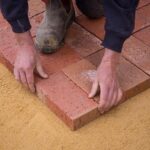Step into the world of crystal clear splendor and uncover the secrets to maintaining a pristine above ground pool. In this guide, you'll discover the best way to clean your pool, from skimming away debris to balancing water chemistry for dazzling results. Say goodbye to algae and stubborn stains as you learn expert techniques for tackling these challenges head-on. With proper filtration and circulation, you'll keep your pool sparkling all year round. Get ready to dive into a world of sparkling perfection.
Key Takeaways
- Regular skimming and cleaning of the pool surface is essential for maintaining cleanliness and preventing debris buildup.
- Proper filtration and circulation, along with maintaining the right water chemistry, help prevent algae growth and keep the pool water crystal clear.
- Regular maintenance of pool skimmers, baskets, filters, and vacuum ensures optimal water circulation, filtration, and cleaning effectiveness.
- Following a regular pool maintenance routine, including cleaning, balancing water chemistry, and using a winter cover, helps prolong the life of the pool and ensures easier reopening next season.
The Importance of Regular Skimming
Regular skimming is essential for keeping your above ground pool clean and free of debris. Skimming not only helps to maintain the overall cleanliness of the pool water, but it also prevents the accumulation of leaves, bugs, and other unwanted materials that can clog the pool's filtration system. By regularly skimming your pool, you can ensure that it remains in optimal condition, providing a safe and enjoyable swimming experience for you and your family.
One of the benefits of regular skimming for pool maintenance is that it helps to improve the efficiency of your pool's filtration system. When debris is left to accumulate in the pool, it can clog the filters, reducing their effectiveness in removing dirt and contaminants from the water. Skimming removes these debris before they have a chance to reach the filtration system, allowing it to function efficiently and prolonging its lifespan.
To choose the right skimming tools for your pool, there are a few factors to consider. Firstly, the size and shape of your pool should be taken into account. If you have a larger pool, you may want to invest in a skimmer with a wider mouth or a telescopic pole to reach all areas of the pool easily. Secondly, consider the type of debris that tends to accumulate in your pool. If you have a lot of leaves or larger debris, a skimmer net with a finer mesh will be more effective in capturing these particles.
Vacuuming Techniques for a Pristine Pool
You can easily maintain a pristine pool by using proper vacuuming techniques. Here are four essential techniques to ensure pool vacuum effectiveness:
- Start with a clean filter: Before you begin vacuuming your pool, it is crucial to have a clean filter. A dirty filter can hinder the vacuum's effectiveness by restricting water flow. So, make sure to clean or backwash your filter before starting the vacuuming process.
- Use the right vacuum head: Different pool surfaces require different vacuum heads. For concrete or plaster pools, use a vacuum head with brushes to scrub away any algae or debris. For vinyl or fiberglass pools, opt for a vacuum head with wheels or nylon brushes to avoid scratching the surface.
- Move methodically: When vacuuming your pool, it's important to move in a methodical pattern. Start at one end of the pool and move slowly and steadily in overlapping rows. This ensures that no area is missed, and the vacuum can effectively pick up all the dirt and debris.
- Empty the skimmer basket and pump basket: As you vacuum, the skimmer basket and pump basket can quickly fill up with debris. To maintain pool vacuum effectiveness, regularly check and empty these baskets. A clogged basket can reduce water flow and hinder the vacuum's ability to pick up debris.
Balancing Water Chemistry for Crystal Clear Results
To achieve optimal results, it's important to maintain a proper balance of chemicals in your pool water. Regular water testing methods are essential to ensure that your pool water is safe and clean for swimming. There are several ways to test the water, including test strips and liquid test kits. These methods allow you to measure the pH level, chlorine and sanitizer levels, alkalinity, and calcium hardness of your pool water. By understanding these levels, you can make the necessary adjustments to maintain a balanced chemical composition.
Sanitizing techniques are crucial for keeping your pool water free from harmful bacteria and algae. Chlorine is the most common sanitizer used in pools, and it helps to kill bacteria and algae. There are different forms of chlorine available, such as tablets, granules, and liquid, each with their own application method. It's important to follow the manufacturer's instructions for the correct dosage and application of the sanitizer.
In addition to chlorine, there are alternative sanitizing methods available, such as saltwater systems or mineral sanitizers. These methods can provide a gentler and more eco-friendly approach to sanitizing your pool water.
Maintaining a proper balance of chemicals and using the right sanitizing techniques will help to keep your pool water crystal clear and safe for swimming. However, sometimes even with the best efforts, algae and other green pool challenges can arise. In the next section, we will discuss effective ways to tackle these issues and bring your pool back to its pristine condition.
Tackling Algae and Other Green Pool Challenges
If you notice algae or other green pool challenges, it's important to take immediate action to restore the water's clarity and safety. Algae can not only make your pool look unappealing, but it can also pose health risks to swimmers. Luckily, there are several effective and eco-friendly methods to prevent and tackle algae growth in your above ground pool.
Here are four key strategies to help you maintain a clear and algae-free pool:
- **Proper filtration and circulation**: Ensure that your pool's filtration system is working optimally. Regularly clean or replace the filter cartridge and backwash the filter to remove debris and prevent clogging. Good circulation helps prevent stagnant water, which can promote algae growth.
- **Maintain proper water chemistry**: Regularly test and balance your pool's water chemistry to prevent algae growth. Keep the pH, alkalinity, and sanitizer levels within the recommended range. This will create an environment that is less conducive to algae growth.
- **Shock the pool**: Shocking your pool with a chlorine-based shock treatment can help kill existing algae and prevent new growth. Choose a non-chlorine shock treatment if you prefer an eco-friendly option.
- **Use algaecides**: Algaecides are chemicals specifically designed to prevent and eliminate algae growth. Look for eco-friendly algaecides that are safe for both swimmers and the environment. Follow the manufacturer's instructions carefully when applying the algaecide.
How to Handle Stubborn Stains on Pool Surfaces
Removing stubborn stains from your pool surfaces can be a challenging task, but there are effective methods available to restore the beauty of your pool. Whether you're dealing with rust stains or oil stains, there are specific techniques you can use to tackle each type of stain.
| Stain Type | Method | Description |
|---|---|---|
| Rust Stains | Chlorine Treatment | Add chlorine to the pool water and brush the affected area. Allow the chlorine to sit for a few hours before brushing again and rinsing thoroughly. Repeat if necessary. |
| Rust Stains | Ascorbic Acid Treatment | Dissolve ascorbic acid in water and apply it directly to the stained area. Let it sit for a few minutes, then brush and rinse. This treatment may need to be repeated for severe stains. |
| Oil Stains | Enzyme Cleaner Treatment | Apply an enzyme cleaner directly to the stain and let it sit for a few minutes. Use a brush to scrub the area, then rinse thoroughly. Repeat if necessary. |
For rust stains, chlorine treatment and ascorbic acid treatment are the most effective options. Chlorine treatment works by oxidizing the rust and breaking it down, while ascorbic acid treatment reduces the iron in the stain, making it easier to remove. It's important to follow the instructions carefully and wear protective gloves and eyewear when using these chemicals.
When it comes to oil stains, using an enzyme cleaner is the way to go. Enzyme cleaners contain enzymes that break down the oil molecules, making them easier to remove. Be sure to choose a cleaner specifically designed for pool surfaces and follow the instructions on the packaging.
Choosing the Right Pool Cleaning Tools
Now that you know how to handle stubborn stains on your pool surfaces, it's time to focus on choosing the right pool cleaning tools. Proper pool maintenance requires the use of effective tools that will help you keep your pool clean and sparkling. Here are four essential pool cleaning tools you should consider:
- Pool Skimmer: A pool skimmer is a must-have tool for any pool owner. It is used to remove leaves, debris, and other floating objects from the water's surface. By regularly skimming the pool, you can prevent these particles from sinking to the bottom and causing further issues.
- Pool Brush: A pool brush is designed to scrub the walls and floor of your pool. It is essential for removing algae, dirt, and other stubborn stains. There are different types of pool brushes available, including nylon, stainless steel, and wire brushes. The type of brush you choose will depend on the surface of your pool.
- Pool Vacuum: A pool vacuum is an excellent tool for deep cleaning your pool. It is specifically designed to remove dirt, debris, and other particles that have settled on the pool floor. There are manual and automatic pool vacuums available, depending on your preference and budget.
- Pool Test Kit: To maintain proper water chemistry, you need to regularly test the pH, chlorine levels, and other chemical balances in your pool. A pool test kit will help you monitor these levels accurately and make the necessary adjustments to keep your pool water safe and clean.
The Best Products for Effective Pool Cleaning
To achieve optimal results when cleaning your pool, it's important to choose the most effective products available. Proper pool maintenance requires the use of high-quality cleaning equipment to ensure that your pool remains sparkling clean and safe for swimming. Here are some of the best products for effective pool cleaning:
| Product | Purpose | Benefits |
|---|---|---|
| Pool Skimmer | Removes debris from the water surface | Keeps the pool free from leaves, insects, and other floating debris |
| Pool Brush | Scrubs the pool walls and floor | Helps remove dirt, algae, and stains, ensuring a clean and inviting pool |
| Pool Vacuum | Cleans the pool bottom and hard-to-reach areas | Efficiently removes dirt, leaves, and algae, leaving your pool spotless |
Using a pool skimmer on a regular basis will prevent debris from sinking to the bottom of the pool, making it easier to maintain cleanliness. A pool brush is essential for scrubbing the walls and floor, especially in areas where the pool vacuum may not reach. It helps in removing dirt, algae, and stubborn stains, ensuring that your pool remains pristine. Additionally, a pool vacuum is a powerful tool that efficiently cleans the pool bottom and hard-to-reach areas, leaving no trace of dirt or debris behind.
Maintaining Proper Water Circulation and Filtration
You can ensure the cleanliness and safety of your swimming pool by maintaining proper water circulation and filtration. By implementing effective water circulation and filtration techniques, you can keep your pool water crystal clear and free from harmful contaminants. Here are four essential steps to help you achieve optimal water quality in your pool:
- **Use a high-quality pool pump**: Invest in a reliable pool pump that is suitable for the size and type of your pool. A properly functioning pump will circulate the water, preventing stagnation and promoting filtration.
- **Clean and maintain your pool filter**: Regularly clean and backwash your pool filter to remove debris and contaminants. Depending on the type of filter you have, this may involve rinsing, hosing, or replacing filter media.
- **Balance water chemistry**: Properly balanced water chemistry is crucial for effective filtration. Test your pool water regularly and adjust the pH, alkalinity, and sanitizer levels as needed. Balanced water chemistry helps prevent the growth of algae and bacteria, improving filtration efficiency.
- **Regularly inspect and clean pool skimmers and baskets**: Skimmers and baskets play a vital role in removing leaves, insects, and other debris from the surface of the pool. Inspect and clean them regularly to ensure optimal water circulation and prevent clogging.
Preventing and Removing Debris From Pool Bottom
To prevent and remove debris from the bottom of your pool, there are a few key steps you should take. First, make sure your pool vacuum is operating effectively, as this will help to remove any dirt or debris that has settled on the pool bottom. Additionally, regularly skimming the surface of the pool to remove leaves and other floating debris will help prevent it from sinking to the bottom. Lastly, don't forget to clean your pool filters regularly to ensure they are functioning properly and able to capture any debris that does make its way to the bottom.
Pool Vacuum Effectiveness
Using a pool vacuum can greatly improve the cleanliness of your above ground pool. It is important to properly maintain your pool vacuum to ensure its effectiveness. Here are some tips for pool vacuum maintenance:
- Regularly check and clean the filter: The filter is an essential component of the pool vacuum and can become clogged with debris over time. Clean or replace the filter as needed to maintain optimal suction.
- Inspect the hoses and connections: Check for any leaks or damage in the hoses and connections. Replace any worn-out parts to prevent loss of suction.
- Keep the pool water balanced: Maintaining the right chemical balance in your pool water can help prevent algae growth and other issues that may affect the performance of your pool vacuum.
- Troubleshoot any issues promptly: If you notice a decrease in suction or any other problems with your pool vacuum, troubleshoot the issue right away. This may involve checking for blockages, adjusting the water flow, or repairing any damaged parts.
Skimming for Debris
If you want to remove debris from your pool effectively, skim the surface regularly using a pool skimmer net. Skimming is one of the most important maintenance tasks for keeping your pool clean and preventing debris buildup. To start, position yourself at one end of the pool and slowly move the skimmer net across the surface, making sure to cover the entire area. Use a gentle sweeping motion to catch leaves, insects, and other debris. Be thorough and take your time to ensure you don't miss anything. It's also helpful to skim the pool in different directions to make sure you don't overlook any debris. By incorporating these skimming techniques into your pool maintenance routine, you can prevent debris from sinking to the bottom and keep your pool looking pristine.
Cleaning Pool Filters
Make sure you regularly clean your pool filters to maintain optimal water quality. Cleaning pool filters is an essential part of pool maintenance that ensures your water remains crystal clear and free from debris. Here are four important things to keep in mind when cleaning your pool filters:
- Use the right technique: When cleaning pool cartridges, remove them from the filter housing and rinse them thoroughly with a hose. For backwashing techniques, turn off the pump, set the valve to "backwash," and let the water flow for a few minutes to flush out any trapped debris.
- Schedule regular cleanings: Aim to clean your pool filters at least once a month or more frequently if you notice reduced water flow or increased debris accumulation.
- Inspect for damage: While cleaning, check the cartridges for any signs of wear and tear. If you notice any cracks or tears, it's time to replace them.
- Keep a maintenance log: Record the dates of each cleaning and any observations about the filter's condition. This will help you stay on top of maintenance and identify any patterns or issues that may arise.
Addressing Cloudy Water Issues
You can easily fix cloudy water in your above ground pool by adjusting the pH levels. Cloudy water is a common issue that many pool owners face, but with the right knowledge and troubleshooting techniques, you can restore your pool's crystal clear splendor. Prevention is key when it comes to cloudy water, so it's important to maintain proper water balance and regularly clean your pool. However, if you find yourself dealing with cloudy water, there are a few steps you can take to address the issue.
The first step in troubleshooting cloudy water is to test the pH levels. A pH level that is too high or too low can contribute to cloudiness. Ideally, the pH level should be between 7.4 and 7.6. If the pH level is too high, you can lower it by adding a pH decreaser. On the other hand, if the pH level is too low, you can raise it by adding a pH increaser. Regularly testing and adjusting the pH levels will help prevent and resolve cloudy water issues.
In addition to adjusting the pH levels, it's important to regularly clean and maintain your pool. This includes skimming the surface for debris, vacuuming the pool floor, and cleaning the pool filters. Clogged or dirty filters can contribute to cloudy water, so it's crucial to clean or replace them as needed. Additionally, regularly shocking the pool with chlorine can help eliminate any bacteria or algae that may be causing cloudiness.
Tips for Winterizing and Closing an Above Ground Pool
Now that summer is coming to an end, it's time to start thinking about winterizing and closing your above ground pool. Properly preparing your pool for the cold months ahead will ensure its longevity and make for an easier reopening next season. Here are some helpful tips to guide you through the process:
- **Drain the pool water**: Begin by draining the pool water to the appropriate level. You want to lower it below the skimmer and return openings to prevent any freezing damage. Use a pump or siphon to remove the water, ensuring it is properly disposed of.
- **Clean and sanitize**: Before closing the pool, it's important to give it a thorough cleaning. Remove any debris, scrub the walls and floor, and vacuum the pool. This will help prevent algae growth and maintain the water's clarity during the winter months.
- **Balance the water chemistry**: Test the pool water and adjust the chemical levels accordingly. You want to ensure that the pH, alkalinity, and sanitizer levels are within the recommended range. This will help prevent any damage to the pool's surface and equipment while it is closed.
- **Install a winter pool cover**: Finally, cover your above ground pool with a winter pool cover. This will protect it from debris, leaves, and harsh weather conditions. Choose a cover specifically designed for above ground pools, ensuring a proper fit and secure fastening.
Frequently Asked Questions
How Often Should I Skim My Above Ground Pool?
To maintain a crystal clear above ground pool, you should regularly skim it to remove debris. The skimming frequency depends on various factors such as the surrounding environment and usage. As a general rule, it is recommended to skim your pool at least once a day. However, during periods of heavy use or if your pool is located near trees, you may need to skim more frequently. By using proper skimming techniques, you can keep your pool looking its best.
What Is the Best Vacuuming Technique for Removing Leaves and Debris From My Pool?
You want your above ground pool to sparkle like a crystal, right? Well, the key to achieving that level of splendor is by mastering the art of vacuuming. When it comes to removing leaves and debris from your pool, you need to employ the most effective vacuuming techniques. This ensures thorough and efficient debris removal, leaving your pool crystal clear and ready for a refreshing swim. So, let's dive into the world of vacuuming and unlock the secrets to a pristine pool.
How Can I Balance the Water Chemistry in My Above Ground Pool to Achieve Crystal Clear Results?
To achieve crystal clear results in your above ground pool, it's important to balance the water chemistry. Start by testing the pH and chlorine levels regularly. Use a pool testing kit to determine the exact measurements. If the pH is too high or too low, adjust it accordingly using pH increaser or decreaser. Additionally, maintain proper chlorine levels by adding chlorine tablets or liquid. Regularly cleaning and maintaining your pool's filters and skimmers will also help in maintaining clarity.
What Are Some Effective Methods for Tackling Algae and Other Green Pool Challenges?
To effectively tackle algae and other green pool challenges, proper pool maintenance is crucial. Preventing algae growth starts with regularly cleaning and maintaining your above ground pool. This includes regularly skimming the surface, brushing the pool walls and floor, and vacuuming any debris. Additionally, ensure that the pool water is properly balanced with the right levels of chlorine and pH. Regularly testing the water and adding necessary chemicals will help keep your pool crystal clear and algae-free.
How Can I Effectively Remove Stubborn Stains From the Surfaces of My Above Ground Pool?
Stubborn stains sullying the serenity of your above ground pool? Seek solace in stain removal techniques that will restore the sparkle and shine. First, identify the type of stain to determine the most effective treatment. For rust, a concoction of vinegar and lemon juice will work wonders. Apply and scrub gently with a brush. Prevent future stains by maintaining proper chemical balance and regular cleaning. Revel in the radiant beauty of your pool, free from unsightly blemishes.
Conclusion
In conclusion, maintaining a clean and sparkling above ground pool is essential for a pleasurable swimming experience. By regularly skimming, vacuuming, and balancing water chemistry, you can ensure crystal clear results. Don't let the fear of algae, stains, or cloudy water discourage you. With the right techniques and proper maintenance, you can overcome any challenges that come your way. So dive in and enjoy your pool knowing that you have the knowledge and tools to keep it in pristine condition.




